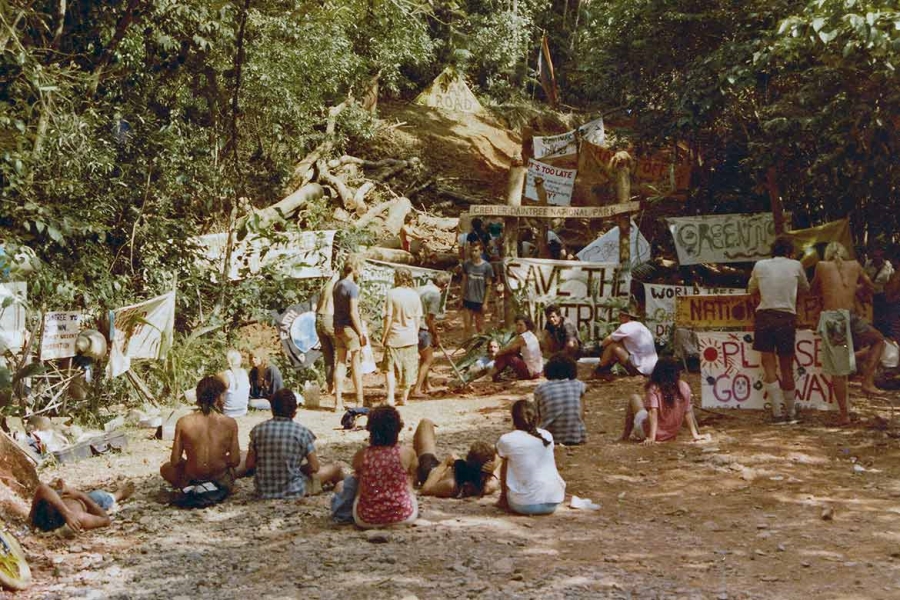History of Development in the Daintree
History of Development in the world’s oldest tropical rainforest
While the Daintree Rainforest is the oldest tropical rainforest in the world, the force of human impact has only been felt in the last century and a half. This means the history of development in the Daintree is like the last paragraph on the final page of a book spanning millions of years!
Early European Settlement of the Daintree
Prior to European settlement in the late 1800s, the Kuku Yalanji people lived in harmony with the tropical rainforest (known as Julaymba) for tens of thousands of years. This Cultural relationship with Country is a fascinating story in itself.
In 1873, just over a century since the Endeavour struck the Great Barrier Reef and Captain James Cook named ‘Cape Tribulation’, colonist George Dalrymple ‘discovered’ the Daintree River and the region began a turbulent journey into colonisation.
The arrival of settlers from continental Europe and China dramatically altered the landscape of the Daintree Rainforest. Gold was discovered in the region, and a lucrative resource of a different kind, Australian Red Cedar, was the start of a thriving logging industry that used the Daintree River to transport the rainforest giants to mills and beyond. Agriculture introduced crops, animals and non-native plants such as Guinea Grass into the region, impacting on the native biology and ecosystems.
For a detailed chronology of the 19th and 20th century in the Daintree, we recommend Destination Daintree’s timeline.
The ‘Daintree Blockade’ and Daintree Subdivision development impacts
Visitors to the Daintree Rainforest are often surprised to find that areas of the Daintree Lowland Rainforest have been cleared for rural development and farming. Deforestation during the former logging era exposed and degraded tracts of the lowland areas. However, it was a history of dramatic actions during the 1980s that thrust the Daintree into the global spotlight – highlighting a patchwork place of land ownership, rights and fragile wilderness.
A subdivision of land in 1982, dubbed in a Wall Street Journal advertisement as ‘Freehold Rainforest’, meant that over a thousand one-acre blocks of rainforest were purchasable for development. The Queensland Government approved the proposal, despite Douglas Shire Council refusing the application.
In 1983 the Douglas Shire Council pushed ahead with a controversial plan to construct a permanent road from Cairns to Cooktown. The sealed road was supported by the Bjelke-Peterson State Liberal Government. Publicity generated by the 1983-84 community protest, known as the ‘Daintree Blockade’ (documented extensively by Bill Wilkie) provided a turning point in the campaign to protect Queensland’s remarkable tropical rainforests.
Daintree Rainforest included in Queensland Wet Tropics World Heritage listing
In 1988, the Hawke Federal Government listed the Queensland Wet Tropics Rainforests as a UNESCO World Heritage Area. Due to its constitutional powers relating to international agreements, the Federal Government was able to overrule the Queensland State Government.
While the Queensland Wet Tropics World Heritage Area included the majority of the upland areas of the Daintree Rainforest, it excluded most of the hill faces and coastal lowlands. Unfortunately, in the decade prior to the World Heritage listing, large sections of existing lowland rainforest were subject to the subdivision by a Cairns property developer for residential development.
Originally there were around 1,100 subdivided blocks of land. Yet, many hundreds were not developed further, possibly because there is no bridge over the Daintree River (access is by ferry) and no mains electricity. The outcome of developers and previous governmental decision-making is a fragmented legacy. Freehold properties, cleared blocks and isolated unprotected patches of intact rainforest chequer the heart of the Daintree Lowlands, surrounded by the protected National Park and the World Heritage Area.
Environmental wake-up call causes historic Government u-turn
While the totality of the actions of subdivision and deforestation are unlikely to be wholly reversed, the significance of the Daintree region’s conservation value due to its biodiversity and plant record has finally been given the attention it deserves.
Various attempts by governments have failed to solve the problems created by the land subdivision. In 1984 the Federal and State Governments funded the $23 million Daintree Rescue Program to be implemented over four years. This was successful in purchasing a number of significant blocks of land for inclusion in the Daintree National Park, as well as developing eco-tourism infrastructure. However large amounts of critical conservation land was still not protected.
Prior to the 2004 election, the Federal Government committed $5 million to the Daintree; however, this was largely diverted to landholder education rather than protecting further areas of the Lowland Rainforest.
In June 2004 the Douglas Shire Council implemented a 12-month moratorium on approval for development in the Daintree while it prepared a Douglas Shire Draft Planning Scheme for the area. Fortunately, the Queensland State Government (again immediately prior to the 2005 State Election) also committed $5 million and following the adoption of the Scheme in 2006 committed another $5 million.
The Douglas Shire Council Planning Scheme protects 350 properties north of the Alexandra Range, which have been acquired with Queensland Government funds. The Scheme also created “Rainforest Residential and Rainforest Tourism Precincts” where development is allowed and will be concentrated. Properties with building permits obtained before the adoption of the Scheme also retained these rights.
Into the future – ‘Healing’ the Daintree
Both the State and Federal Governments have indicated that they have no intention of funding further ‘buy back’ schemes in the Daintree.
Since the subdivision, Rainforest Rescue has worked to purchase and protect land containing intact high-conservation value rainforest. Areas identified by the Federal Government that contain Critically endangered and Endangered natural habitat are of priority, especially when there is potential to connect up intact rainforest to create wildlife corridors. In doing so, its possible to retain the genetic diversity of threatened species in this contentious region.
Working with the existing Daintree community, including the traditional Indigenous people who make up the many clans of the Kuku Yalanji, Rainforest Rescue is committed to helping with the ‘healing’ of the tropical rainforest.
Seeking a sustainable solution for an environment that has witnessed dramatic changes in such a short space of biological time is critical to the next stage of ‘development’ for the Daintree.

Donate Now
When you give generously, you become part of a committed team of individuals who collectively are helping to preserve some of the most biodiverse habitats and the species that live within them on this planet. Become a Rainforest Guardian today!
purchase
and
protect
>>>
and
protect
>>>



